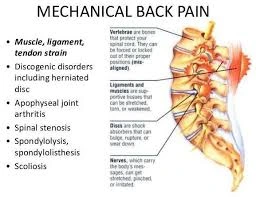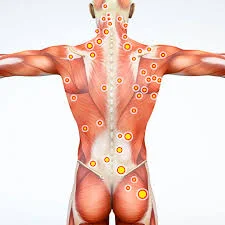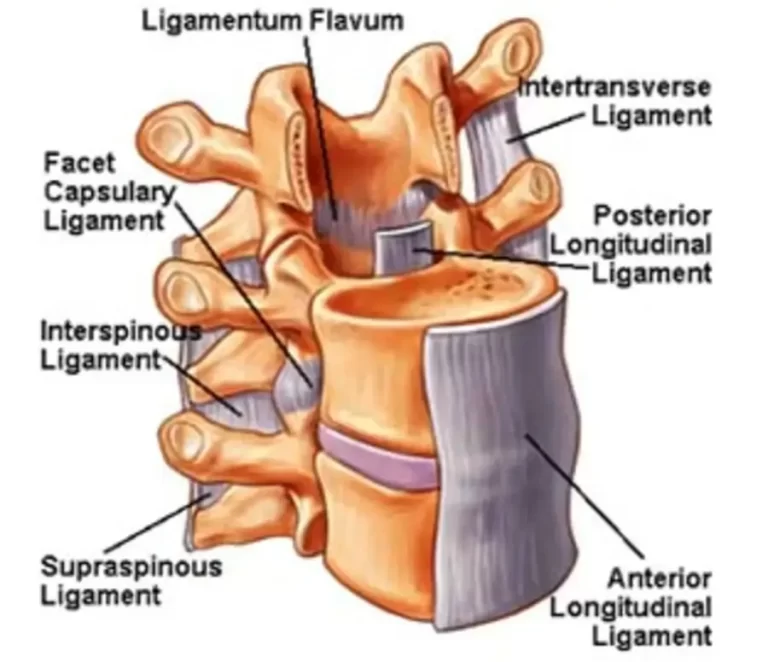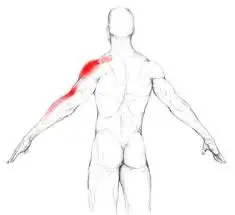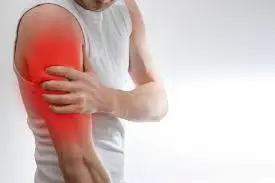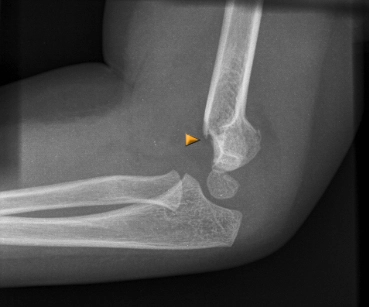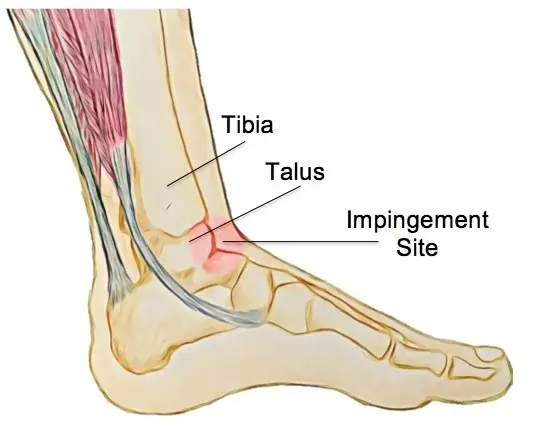Mechanical Back Pain
What is Mechanical Back Pain?
Mechanical back pain is a common condition that affects the spine, intervertebral discs, ligaments, muscles, or other supporting structures in the back. It is one of the most common forms of back pain and is typically associated with physical strain, poor posture, or repetitive movements. It is named “mechanical” because it often occurs from mechanical stress or strain on the spine, commonly owing to bad posture, repetitive activities, and lifting large objects incorrectly.
When a back structure, such as an intervertebral disc, joint, or bone, is compromised to the point of pain, mechanical back pain results. A force applied to a structure above a certain threshold irritates the tissue and reduces discomfort. In the event that more than one nerve root is impacted, the pain may spread from the back along the damaged nerve’s course, down the leg, and occasionally even to the foot.
Mechanical back pain can develop gradually over time for unknown reasons, or it might result from a tissue injury sustained in an accident or fall. Over time, bad eating habits, inappropriate exercise techniques, and repetitive spinal movements can all contribute to the development of mechanical back pain.
What causes Mechanical Back Pain?
Sometimes, a single accident or vigorous activity might cause the pain you are feeling. Even still, eighty percent of the time the particular cause of the pain remains unidentified. Thankfully, most people who receive basic treatment recover in a comparatively shorter amount of time.
What are the symptoms of Mechanical Back Pain?
You may have radiated (spreading) pain to your legs and buttocks. Mechanical back pain may also cause spasms in a large number of persons.
- Pain: It could originate in a particular spot on the back or spread to other body areas like the legs, hips, or buttocks. Generally, specific motions or activities make the pain worse; resting can help.
- Stiffness: It may be difficult to bend, twist, or move freely because of a stiff back.
- Muscle spasms
- Limited range of motion: You could find it challenging to carry out specific motions or tasks that call for bending, lifting, or twisting.
- Tenderness: There’s a chance that the damaged area is sensitive.
How is back pain diagnosed?
Your medical management provider will determine whether you have mechanical back pain by carefully reviewing your medical history and performing a physical examination. After that, he or she will work together with you to develop a suitable treatment strategy.
Further testing is not necessarily required if your medical care provider has decided that your back pain is mechanical. Further testing may be performed if your symptoms and the examination point to the possibility of an infection, cancer, or pinched nerve. Blood tests, x-rays, computed tomography (CT) scans, magnetic resonance imaging (MRI), and/or nerve conduction studies are examples of additional testing that may be performed.
How is Mechanical Back Pain treated?
Usually, self-care techniques, conservative therapy, and occasionally, medical interventions are used to alleviate mechanical back pain.
For some individuals, a comprehensive physical therapy program may be advised in order to manage persistent mechanical discomfort.
- Physical exercise: To promote a speedy recovery from back discomfort, medical officer providers occasionally advise advanced physical activity. If your back discomfort is moderate to light, you may find it motivating to keep up a nearly regular schedule right away.
- Ice and hot application: It is helpful to apply hot and cold compresses in succession to the lower back in order to reduce inflammation and relax the muscles. Utilize only that program if you discover it to be more helpful than the others.
- Medication: A muscle relaxant may be administered for a brief duration (3 to 4 days) if you experience muscle spasms. Pain relief options include nonsteroidal anti-inflammatory medicines (NSAIDs), such as ibuprofen or naproxen, which can be purchased over the counter. Rarely is the need for stronger prescription painkillers necessary.
- Physical treatment: In certain situations, physical therapy may be a crucial component of the recovery process for severe back pain. To encourage quick healing, it is crucial that you collaborate with a physical therapist skilled in this training regimen. Active physical therapy can help you recover more quickly and go back to work and other activities as soon as possible. Active physical therapy is an exercise regimen that may need you to perform at-home exercises while keeping a close eye on things as often as every two to three hours. The workouts typically take five minutes to complete and don’t require any specialized equipment or a gym membership.
- Injections: To temporarily relieve pain and reduce inflammation, corticosteroid injections may occasionally be injected directly into the affected area.
- Massage therapy: When used with other therapies, it may be advantageous.
- Surgery (in uncommon cases): When non-invasive therapy options are exhausted and a structural issue (such as a herniated disc or spinal stenosis) is clearly the source of the back pain, surgery is usually taken into consideration. Surgical options change based on the particular ailment.
For an accurate diagnosis and individualized treatment plan, it is imperative that you speak with a medical practitioner if you are suffering from back pain. They can help determine the root cause of your discomfort and suggest the best course of action for your unique situation.
Physical therapy Treatment
Physical Therapy for Mechanical Back Pain:
Moving about physical rehabilitation could be recommended as the first pain subsides. Engaging in physical activity enhances blood circulation and encourages the preferred healing of strained muscles.
Techniques used in physical therapy and rehabilitation help to reduce mechanical back pain and relieve strained muscles.
Depending on the degree of the condition, returning to work and engaging in routine activities after experiencing mechanical back pain can vary. In most situations, back discomfort resolves in a few days or weeks, allowing patients to resume their regular activities. However, if one has mechanical back discomfort, it is best to stay away from physically demanding activities, bending over, and lifting large weights.
Adhering to a nutritious diet, engaging in regular exercise, and maintaining a healthy routine can all help to prevent future episodes of back pain. To stay healthy, abstain from alcohol, drink plenty of water, manage your weight, and avoid smoking.
Exercises for Mechanical Back Pain
Discover some of the finest exercises for strengthening the back that can help with mechanical back pain.
- Static Back Exercise: Press the lower back until it meets the ground, then release the pressure.
- Pelvic Bridging: Lift your hips and lower body, hold them in place, then let go.
- Knee to chest: Bend one knee such that it nearly touches your chest.
- Cat-Cow Stretch: On all fours, perform the cat-cow stretch. Form a back curve by strengthening your back, then let go. Walking in a swimming pool and aquatic workouts can help reduce mechanical back pain and should be conducted as suggested.
Prevention
The biomechanical elements, work posture, material and load handling, repetitive motions, job descriptions, and occupational health and safety should all be included in the physical measures. Communication, resource management, job descriptions, time management at work, teamwork, work paradigms, cooperative working, prepared culture, prepared networking, teleworking, and quality management should all be prioritized in prepared prevention.
Studying psychological processes, the mental strain at work, decision-making, expert performance, man-machine interaction, stress, and training are all part of the cognitive component. This way, the psychosocial factors—such as dissatisfaction with jobs, repetitive tasks, fatigue from work overload, lack of independence, and competition with coworkers—that contribute to the onset of occupational low back pain can be avoided.
Prognosis
The appearance of pictures (disc degeneration or osteophytes) of the patient’s lumbar spine should not be used to determine the vocational prognosis of patients with chronic low back pain. If patients receive the right care, the presence of significant indicators of non-organic pain does not always indicate a bad prognosis. If a person with negative psychosocial characteristics is not receiving appropriate treatment, it may indicate that they will miss more work days.
One group of researchers has demonstrated that even patients with seemingly unrefractory typical low back pain that is strongly correlated with psychosocial factors may show notable improvements if they receive multidisciplinary rehabilitation that appropriately distributes the somatic symptoms rather than just the localized physical pain or if they receive supposedly insignificant anatomic findings. These conclusions that even in long-term cases, people with persistent low back pain can benefit from treatment and improvement—were corroborated by another study.
Summary
A typical form of back pain brought on by strain or stress on the back’s tissues is mechanical back pain, also referred to as non-specific back pain. It frequently has to do with bad posture, clumsy quick movements, or repetitive motions.
Treatment for mechanical back pain usually consists of conservative therapies plus self-care techniques. Self-care techniques include taking it easy, applying heat or ice, using over-the-counter analgesics, and keeping a healthy weight. Physical therapy, chiropractic adjustments, massage treatment, and, if required, medication are examples of conservative therapies.
For an accurate diagnosis and to receive the right treatment depending on the underlying reason and severity of the mechanical back pain, it’s crucial to speak with a healthcare provider. They can help you take the appropriate actions to control and lessen your symptoms.
FAQs
Does lower back pain improve with walking?
Taking walks: According to a preliminary study, walking or brisk walking (also known as Nordic walking) can help reduce back discomfort if done on a regular basis (every two days, for example) for 30 to 60 minutes.
Does heat help with back pain?
Back pain that is severe and persistent can be helped by heat therapy. Applying heat to the back might help relax the muscles and lessen pain. The blood vessels may dilate when heat is applied to the muscles, improving circulation. This encourages any wounded muscle to recover.
What does persistent mechanical pain mean?
Lower back pain that is mechanical in nature fluctuates in intensity depending on the activity or posture you’re in. It is the most prevalent problem, affecting between 85% and 90% of people at some point in their lives.
What exactly is a back mechanical issue?
Mechanical low back pain is a type of pain that is associated with movement in the lumbar and sacral regions of the spine and cannot be directly linked to a problem with one section of the spine. The most common type of back pain is this one.
How is mechanical back pain diagnosed?
Physical examination of a patient with back pain should entail a Range Of Motion (ROM) and a thorough neurologic examination, encompassing an assessment of peripheral motor function, sensation, and deep tendon reflexes. With the patient in a supine posture, do a straight-leg examination. Note how each leg is increased in response.
Is there a cure for mechanical back pain?
Ninety percent of patients with severe low back pain experience no symptoms within one to two weeks. Within three months, a significant portion of the remaining estimated 10% to 15% recover. Back pain recurrence is not uncommon.
What differentiates non-mechanical from mechanical back pain?
A back muscular tension brought on by an injury sustained during sports is one example. In general, nonspecific back pain is mechanical in nature, meaning that it is triggered by the motion of the spine. Mechanical discomfort may be caused by imbalances in the muscles or by aging joints.
Which type of pain is mechanical?
Mechanical pain is frequently accompanied by severe inflammation. Common causes of mechanical pain include tendinitis, osteoarthritis, and low back conditions.
References
- Dr.RaviPatel. (2023, July 9). Mechanical Back Pain – Cause, Symptoms, Treatment. Samarpan Physiotherapy Clinic. https://samarpanphysioclinic.com/mechanical-back-pain/
- Dhameliya, N. (2023, November 12). Back Pain, Cause, Examination, Physiotherapy Treatment. Samarpan Physiotherapy Clinic. https://samarpanphysioclinic.com/back-pain-treatment-ahmedabad/

